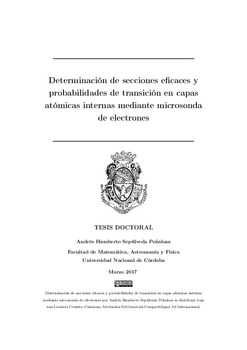| dc.contributor.advisor | Castellano, Gustavo Eugenio | |
| dc.contributor.author | Sepúlveda Peñaloza, Andrés Humberto | |
| dc.date.accessioned | 2017-12-22T15:21:04Z | |
| dc.date.available | 2017-12-22T15:21:04Z | |
| dc.date.issued | 2017-03 | |
| dc.identifier.uri | http://hdl.handle.net/11086/5757 | |
| dc.description | Tesis (Doctor en Física)--Universidad Nacional de Córdoba, Facultad de Matemática, Astronomía, Física y Computación, 2017. | es |
| dc.description.abstract | Se analizaron espectros de rayos x de muestras puras y extensas de Ru, Ag,Te, Fe y Ni , generados por impacto de electrones y colectados con un sistema dispersivo en longitudes de onda, el cual permite discriminar de manera adecuada las transiciones radiativas asociadas a los decaimientos hacia las capas L. Se determinaron energías características, probabilidades relativas de transición, anchos naturales de línea y de niveles atómicos. Se caracterizaron también las estructuras satélites y bandas RAE. Por otro lado, se determinaron las secciones eficaces de ionización de las subcapas L1, L2 y L3, y de producción total de rayos x para la capa L, analizando espectros provenientes de una muestra delgada de Ag, comparando los valores obtenidos con aproximaciones teóricas. Se abordó además la determinación de secciones eficaces en muestras gruesas estudiando los casos particulares de la capa K de Si y las subcapas L de Ag y Sn. Se realizaron comparaciones de los distintos métodos propuestos, considerando los resultados obtenidos en virtud de sus alcances y dificultades de implementación. | es |
| dc.description.abstract | We analyzed x-ray spectra from Ru, Ag, Te, Fe and Ni pure bulk samples, generated by electron impact and collected with a wavelength dispersive system which allows to adequately discriminate the radiative transitions associated with the decays generated by L-shell vacancy states. Characteristic energies, relative probabilities transitions, natural line widths and atomic levels widths were determined. Satellites structures and radiative Auger emissions bands were also characterized.On the other hand, ionization cross sections for L1, L2 and L3 subshells and total x-ray production cross sections for the L shell for an Ag thin sample were determided and compared with theoretical approximations. Additionally, the determination of cross sections in thick samples was carried out by studying the particular cases of the Si K shell and the Ag and Sn L subshells. Comparisons of the different methods proposed were made, considering their scope and implementation difficulties. | en |
| dc.language.iso | spa | es |
| dc.rights | Atribución-NoComercial-CompartirIgual 4.0 Internacional. | |
| dc.rights.uri | https://creativecommons.org/licenses/by-nc-sa/4.0/ | |
| dc.subject | X-ray and gamma-ray spectrometers | es |
| dc.subject | X- and gamma-ray sources, mirrors, gratings, and detectors | es |
| dc.subject | Atomic excitation and ionization | es |
| dc.subject | X-ray spectra | es |
| dc.subject | Intensities and shapes of atomic spectral lines | es |
| dc.subject.other | Espectros de rayos X | es |
| dc.subject.other | Espectrómetro dispersivo en longitudes de onda | es |
| dc.subject.other | Líneas satélites | es |
| dc.subject.other | Bandas RAE | es |
| dc.subject.other | Sección eficaz de ionización | es |
| dc.title | Determinación de secciones eficaces y probabilidades de transición en capas atómicas internas mediante microsonda de electrones | es |
| dc.type | bachelorThesis | es |





